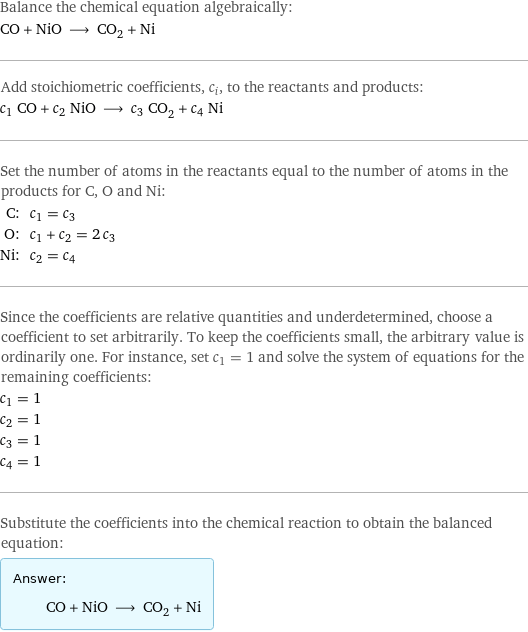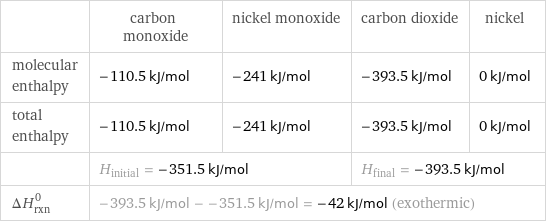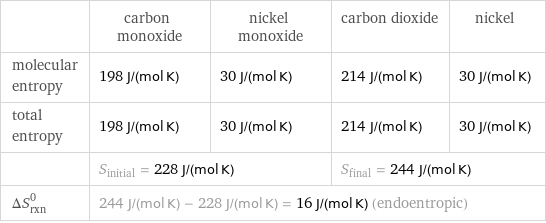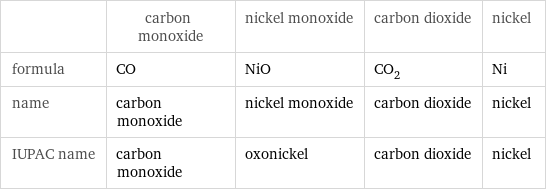Input interpretation

CO carbon monoxide + NiO nickel monoxide ⟶ CO_2 carbon dioxide + Ni nickel
Balanced equation

Balance the chemical equation algebraically: CO + NiO ⟶ CO_2 + Ni Add stoichiometric coefficients, c_i, to the reactants and products: c_1 CO + c_2 NiO ⟶ c_3 CO_2 + c_4 Ni Set the number of atoms in the reactants equal to the number of atoms in the products for C, O and Ni: C: | c_1 = c_3 O: | c_1 + c_2 = 2 c_3 Ni: | c_2 = c_4 Since the coefficients are relative quantities and underdetermined, choose a coefficient to set arbitrarily. To keep the coefficients small, the arbitrary value is ordinarily one. For instance, set c_1 = 1 and solve the system of equations for the remaining coefficients: c_1 = 1 c_2 = 1 c_3 = 1 c_4 = 1 Substitute the coefficients into the chemical reaction to obtain the balanced equation: Answer: | | CO + NiO ⟶ CO_2 + Ni
Structures

+ ⟶ +
Names

carbon monoxide + nickel monoxide ⟶ carbon dioxide + nickel
Reaction thermodynamics
Enthalpy

| carbon monoxide | nickel monoxide | carbon dioxide | nickel molecular enthalpy | -110.5 kJ/mol | -241 kJ/mol | -393.5 kJ/mol | 0 kJ/mol total enthalpy | -110.5 kJ/mol | -241 kJ/mol | -393.5 kJ/mol | 0 kJ/mol | H_initial = -351.5 kJ/mol | | H_final = -393.5 kJ/mol | ΔH_rxn^0 | -393.5 kJ/mol - -351.5 kJ/mol = -42 kJ/mol (exothermic) | | |
Entropy

| carbon monoxide | nickel monoxide | carbon dioxide | nickel molecular entropy | 198 J/(mol K) | 30 J/(mol K) | 214 J/(mol K) | 30 J/(mol K) total entropy | 198 J/(mol K) | 30 J/(mol K) | 214 J/(mol K) | 30 J/(mol K) | S_initial = 228 J/(mol K) | | S_final = 244 J/(mol K) | ΔS_rxn^0 | 244 J/(mol K) - 228 J/(mol K) = 16 J/(mol K) (endoentropic) | | |
Equilibrium constant
![Construct the equilibrium constant, K, expression for: CO + NiO ⟶ CO_2 + Ni Plan: • Balance the chemical equation. • Determine the stoichiometric numbers. • Assemble the activity expression for each chemical species. • Use the activity expressions to build the equilibrium constant expression. Write the balanced chemical equation: CO + NiO ⟶ CO_2 + Ni Assign stoichiometric numbers, ν_i, using the stoichiometric coefficients, c_i, from the balanced chemical equation in the following manner: ν_i = -c_i for reactants and ν_i = c_i for products: chemical species | c_i | ν_i CO | 1 | -1 NiO | 1 | -1 CO_2 | 1 | 1 Ni | 1 | 1 Assemble the activity expressions accounting for the state of matter and ν_i: chemical species | c_i | ν_i | activity expression CO | 1 | -1 | ([CO])^(-1) NiO | 1 | -1 | ([NiO])^(-1) CO_2 | 1 | 1 | [CO2] Ni | 1 | 1 | [Ni] The equilibrium constant symbol in the concentration basis is: K_c Mulitply the activity expressions to arrive at the K_c expression: Answer: | | K_c = ([CO])^(-1) ([NiO])^(-1) [CO2] [Ni] = ([CO2] [Ni])/([CO] [NiO])](../image_source/70a80c53b2e597a8653e0ae923d899b4.png)
Construct the equilibrium constant, K, expression for: CO + NiO ⟶ CO_2 + Ni Plan: • Balance the chemical equation. • Determine the stoichiometric numbers. • Assemble the activity expression for each chemical species. • Use the activity expressions to build the equilibrium constant expression. Write the balanced chemical equation: CO + NiO ⟶ CO_2 + Ni Assign stoichiometric numbers, ν_i, using the stoichiometric coefficients, c_i, from the balanced chemical equation in the following manner: ν_i = -c_i for reactants and ν_i = c_i for products: chemical species | c_i | ν_i CO | 1 | -1 NiO | 1 | -1 CO_2 | 1 | 1 Ni | 1 | 1 Assemble the activity expressions accounting for the state of matter and ν_i: chemical species | c_i | ν_i | activity expression CO | 1 | -1 | ([CO])^(-1) NiO | 1 | -1 | ([NiO])^(-1) CO_2 | 1 | 1 | [CO2] Ni | 1 | 1 | [Ni] The equilibrium constant symbol in the concentration basis is: K_c Mulitply the activity expressions to arrive at the K_c expression: Answer: | | K_c = ([CO])^(-1) ([NiO])^(-1) [CO2] [Ni] = ([CO2] [Ni])/([CO] [NiO])
Rate of reaction
![Construct the rate of reaction expression for: CO + NiO ⟶ CO_2 + Ni Plan: • Balance the chemical equation. • Determine the stoichiometric numbers. • Assemble the rate term for each chemical species. • Write the rate of reaction expression. Write the balanced chemical equation: CO + NiO ⟶ CO_2 + Ni Assign stoichiometric numbers, ν_i, using the stoichiometric coefficients, c_i, from the balanced chemical equation in the following manner: ν_i = -c_i for reactants and ν_i = c_i for products: chemical species | c_i | ν_i CO | 1 | -1 NiO | 1 | -1 CO_2 | 1 | 1 Ni | 1 | 1 The rate term for each chemical species, B_i, is 1/ν_i(Δ[B_i])/(Δt) where [B_i] is the amount concentration and t is time: chemical species | c_i | ν_i | rate term CO | 1 | -1 | -(Δ[CO])/(Δt) NiO | 1 | -1 | -(Δ[NiO])/(Δt) CO_2 | 1 | 1 | (Δ[CO2])/(Δt) Ni | 1 | 1 | (Δ[Ni])/(Δt) (for infinitesimal rate of change, replace Δ with d) Set the rate terms equal to each other to arrive at the rate expression: Answer: | | rate = -(Δ[CO])/(Δt) = -(Δ[NiO])/(Δt) = (Δ[CO2])/(Δt) = (Δ[Ni])/(Δt) (assuming constant volume and no accumulation of intermediates or side products)](../image_source/ebe070d31405a2510132a6a93996b8c9.png)
Construct the rate of reaction expression for: CO + NiO ⟶ CO_2 + Ni Plan: • Balance the chemical equation. • Determine the stoichiometric numbers. • Assemble the rate term for each chemical species. • Write the rate of reaction expression. Write the balanced chemical equation: CO + NiO ⟶ CO_2 + Ni Assign stoichiometric numbers, ν_i, using the stoichiometric coefficients, c_i, from the balanced chemical equation in the following manner: ν_i = -c_i for reactants and ν_i = c_i for products: chemical species | c_i | ν_i CO | 1 | -1 NiO | 1 | -1 CO_2 | 1 | 1 Ni | 1 | 1 The rate term for each chemical species, B_i, is 1/ν_i(Δ[B_i])/(Δt) where [B_i] is the amount concentration and t is time: chemical species | c_i | ν_i | rate term CO | 1 | -1 | -(Δ[CO])/(Δt) NiO | 1 | -1 | -(Δ[NiO])/(Δt) CO_2 | 1 | 1 | (Δ[CO2])/(Δt) Ni | 1 | 1 | (Δ[Ni])/(Δt) (for infinitesimal rate of change, replace Δ with d) Set the rate terms equal to each other to arrive at the rate expression: Answer: | | rate = -(Δ[CO])/(Δt) = -(Δ[NiO])/(Δt) = (Δ[CO2])/(Δt) = (Δ[Ni])/(Δt) (assuming constant volume and no accumulation of intermediates or side products)
Chemical names and formulas

| carbon monoxide | nickel monoxide | carbon dioxide | nickel formula | CO | NiO | CO_2 | Ni name | carbon monoxide | nickel monoxide | carbon dioxide | nickel IUPAC name | carbon monoxide | oxonickel | carbon dioxide | nickel